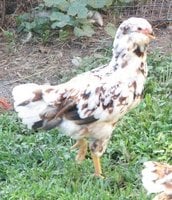Russian Orloff chickens are one of those breeds that captivates those of us who raise them. They are very alert and active, the hens are friendly and calm natured, the roosters are non human aggressive and look after the hens to a degree you seldom see in other breeds.
Although most think they are from Russia, they most likely originated in the mid-east. I have seen news footage from Afghanistan and Turkey that showed some excellent stock running wild in the background. They were perfected, like many birds, by breeders in Germany and introduced in the 1800's to America by a Count Orloff, from whom they take their name. They were dropped from the Standard Of Perfection in the early 1900's due to lack of interest, but a few dedicated breeders have kept the breed alive over the years, and they now seem to be on the upswing again, although still considered rare and endangered.
There are a few good breeders of Orloffs in the USA and if you are considering raising these delightful breeds, I'd highly suggest buying from a breeder. Most hatchery Orloffs have been crossed at some point with speckled Sussex, so you will get some throwback traits such as straight combs, white legs and skin and white eggs from most hatchery birds. A good specimen is impressive, with even spangling on hens and yellow feet, muffs, beards, a ruffed neck and deep-set eyes on both hens and roosters. Roosters should have a very upright stance, and have the most amazing mahogany color of any chicken.
Besides the spangled birds which are more common although still fairly rare, Orloffs are also available in other super rare colors I have seen such as black, white, mahogany and cuckoo. Breeders are also working on adding additional colors.
Laying ability seems to vary by strain. One of our strains is excellent, laying all year and seldom missing an egg a day although most eggs are too light in color. Another strain we work with are poor layers and have fertility problems and smaller, weaker chicks but are larger at maturity and somewhat better in coloration and lay a darker egg.
In my opinion, the perfect specimen is yet to be breed, but with several serious breeders working with them now, that goal comes closer every year.
All in all, I highly recommend Orloffs to anyone with at least a little room to free range.
Although most think they are from Russia, they most likely originated in the mid-east. I have seen news footage from Afghanistan and Turkey that showed some excellent stock running wild in the background. They were perfected, like many birds, by breeders in Germany and introduced in the 1800's to America by a Count Orloff, from whom they take their name. They were dropped from the Standard Of Perfection in the early 1900's due to lack of interest, but a few dedicated breeders have kept the breed alive over the years, and they now seem to be on the upswing again, although still considered rare and endangered.
There are a few good breeders of Orloffs in the USA and if you are considering raising these delightful breeds, I'd highly suggest buying from a breeder. Most hatchery Orloffs have been crossed at some point with speckled Sussex, so you will get some throwback traits such as straight combs, white legs and skin and white eggs from most hatchery birds. A good specimen is impressive, with even spangling on hens and yellow feet, muffs, beards, a ruffed neck and deep-set eyes on both hens and roosters. Roosters should have a very upright stance, and have the most amazing mahogany color of any chicken.
Besides the spangled birds which are more common although still fairly rare, Orloffs are also available in other super rare colors I have seen such as black, white, mahogany and cuckoo. Breeders are also working on adding additional colors.
Laying ability seems to vary by strain. One of our strains is excellent, laying all year and seldom missing an egg a day although most eggs are too light in color. Another strain we work with are poor layers and have fertility problems and smaller, weaker chicks but are larger at maturity and somewhat better in coloration and lay a darker egg.
In my opinion, the perfect specimen is yet to be breed, but with several serious breeders working with them now, that goal comes closer every year.
All in all, I highly recommend Orloffs to anyone with at least a little room to free range.

